
Novacap offers a line of pulsed power capacitors that exhibit high reliability afforded by ceramic multilayer fabrication. They are available in many sizes including standard 1210, 1825, 3040, 3640 and 7565. Custom design sizes and assemblies are also available.
The capacitors will function and have been shock tested at 10 kG at 0,5 mS, 12 kG at 0,4 mS, and 60 kG at 50 μS. They are radiation hardened, displaying less than 5% voltage/charge loss at 10 kRad and less than 10% voltage/charge loss at 100 kRad. The capacitors operate most efficiently with a high internal voltage stress and deliver maximum energy at these elevated voltages. Typical voltage ratings for these components are between 500 V d.c. and 2800 V d.c., depending on the application. Individual chip capacitors can also be assembled into parallel, series or series-parallel arrangements for higher voltage and energy requirements. The capacitors can be integrated with other components to make efficient firing circuits.
Applications include detonation circuitry, seismic evaluation, ignitors, lasers, power storage modules, pulsed lighting, temperature sensing, photoflash, strobe lighting, power interruption, ballast capacitors and snubbers.
The capacitors are manufactured using a dielectric formulation that has a positive voltage coefficient, positive temperature coefficient and a high dielectric constant. These properties can provide up to 7 J/cc of discharge energy depending on part size, capacitance value and voltage applied, surpassing energy density of conventional electrolytic capacitors, X7R or temperature compensating dielectrics.
X7R capacitors only have a slight positive linear increase in energy because the dielectric constant is decreasing as the voltage potential increases. Pulsed power capacitors increase in deliverable energy much faster than conventional dielectrics undervoltage because the electric field induces a phase transition that gives a positive voltage coefficient. Figure 1 shows the temperature coefficient of pulsed power capacitors.
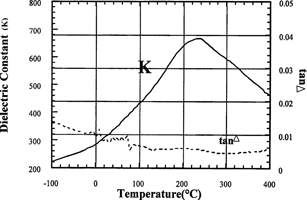
Figure 2 shows the active energy density versus the applied field for pulsed power capacitors and X7R dielectric material. The unique dielectric material and chip construction provides for minimal internal losses, allowing maximum energy delivery with pulses that are exceedingly fast.
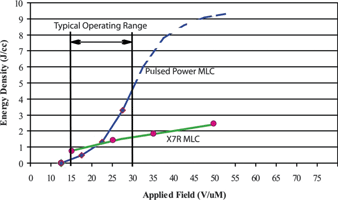
The storage of electrical energy is different than in conventional capacitors. The charged state from the induced field causes a phase transition. The energy is stored in this phase transition, not in the displacement of charges that is seen in linear dielectrics. Most of the electrical energy is stored at high field levels, allowing the pulsed power capacitors to deliver more energy at the voltage needed.
The phase transition can be distinguished by triangular wave testing. The current through a capacitor is the capacitance multiplied by the rate of voltage change. The triangle wave test is a good method of measuring the electrical properties of nonlinear capacitors because the rate of voltage change is a constant. An ideal linear capacitor driven by a triangle wave has a square wave for the current, as shown in Figure 3. The pulsed power capacitor will have a current waveform as shown in Figure 4.
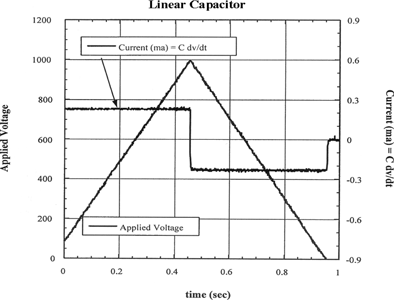
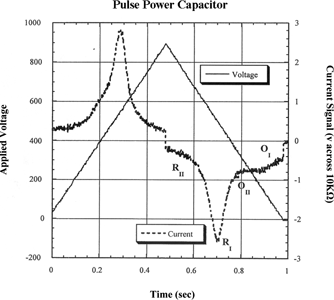
A typical building block is a 3040 size with a nominal capacitance of 50 nF at 1500 V d.c. rating and a 3640 size 70 nF at 1100 V d.c. rating. Typical current deliveries for these types of capacitors are shown in Figures 5 and 6. These rates are dependent on circuit load and resistance/inductance. Capacitor size, length/width and thickness can be changed to achieve similar delivered energy by maintaining similar volume ratio, ie, 0,360 x 0,400 x 0,100 will achieve the same energy density as 0,350 x 0,300 x 0,137.
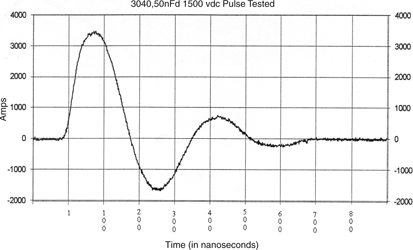
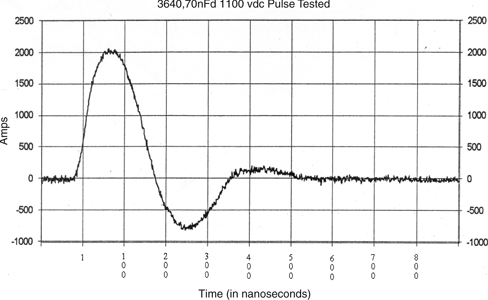
| Tel: | +27 21 555 8400 |
| Email: | [email protected] |
| www: | www.rfdesign.co.za |
| Articles: | More information and articles about RF Design |

© Technews Publishing (Pty) Ltd | All Rights Reserved